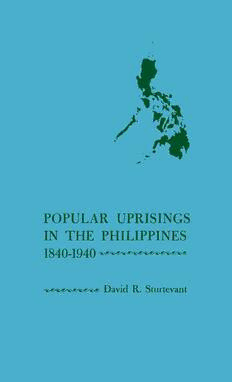
Popular Uprisings in the Philippines, 1840-1940 PDF
Preview Popular Uprisings in the Philippines, 1840-1940
POPULAR UPRISINGS IN THE PHILIPPINES 1840-1940 POPULAR UPRISINGS IN THE PHILIPPINES 1840-1940 David R. Sturtevant Cornell University Press ITHACA AND LONDON Copyright © 1976 by Cornell University All rights reserved. Except for brief quotations in a review, this book, or parts thereof, must not be reproduced in any form without permission in writing from the publisher. For information address Cornell University Press, 124 Roberts Place, Ithaca, New York 14850. First published 1976 by Cornell University Press. Published in the United Kingdom by Cornell University Press Ltd., 2-4 Brook Street, London W1Y 1AA. International Standard Book Number 0-8014-0877-6 Library of Congress Catalog Card Number 75-36521 Printed in the United States of America by York Composition Co., Inc. To Joy A cknowledgments Those who engage in historical research accumulate obligations. Like other American students of the Philippines, I have collected more than my share on both sides of the Pacific. Scores of kind people have assisted me—too many by far to thank individually. The help of foundations and the important contributions of several colleagues and friends, however, must be acknowledged. The book would have been impossible without grants for extended study in Washington, D.C., and Manila. Through its Mack Founda tion Program, Muskingum College supported research and writing over two summers. The Committee on International Exchange of Persons subsidized a year in the Philippines as a Fulbright-Hays Researcher. And a grant from the Joint Committee of the American Council of Learned Societies and the Social Science Research Council enabled me to complete my investigations and finish the manuscript. Theodore Friend and John Larkin read the draft and offered pertinent criticisms to strengthen the final product. While the aid of these organizations and individuals was indispensable, none of them should be held responsible for any errors of fact or interpretation contained in the text. Among the Americans who moved me or my work forward at criti cal junctures six deserve special thanks. I would like to express indebt edness to Claude Buss, Felix Keesing, Russell Fifield, Arthur Wright, Frank Golay, and—for advice and help beyond measure—the late Harry Benda. Numerous Filipinos also facilitated my inquiries in Manila and the provinces. For gracious counsel and constant encour agement, I owe particular debts of gratitude to Josefa Saniel, F. Sionil Jose, Teodoro Agoncillo, Jeremias Adia, and the Reverend Conrado Generalla. Friends and neighbors in New Concord contributed much of their 8 A cknowledgments energy and time to the completion of this book. For converting my cramped scrawl into type and for attempting to shape my unrestrained prose into a rough approximation of the English language, I am especially grateful to Josephine Maddox. Similar appreciation is due Marge Hawkenberry and Eleanore Smith for preparing the final manuscript. John Armstrong read proof and thoughtfully restricted himself to Scot-like observations on diction or punctuation. Admini strators and fellow teachers at Muskingum, moreover, always tried to help my work toward completion. Several publications and publishers granted permission to use sec tions of my articles. For their courtesy I would like to thank the Journal of Asian Studies, Solidarity, Asia Studies, and the Publica tions Office of the Ohio University Center for International Studies. Document depositories were equally cooperative. The Manuscript Division, Library of Congress, consented to the reproduction of a letter from the Leonard Wood Papers; and the Ayer Collection of Newberry Library approved the incorporation of several brief quota tions from a nineteenth-century manuscript by Manuel Sancho. Robert Warner of the Michigan Historical Collections and Betty Hayden of Ann Arbor extended every kindness to me—including unrestricted use of important materials from the Joseph R. Hayden Papers. Last but not least, I must acknowledge the four people who assisted most of all. For constant and good-humored toleration, I thank Lynne, Mark, and Jim Sturtevant. And for putting up with me and this book far longer than I had any right to expect, I express profound admira tion and love for my wife, Joy. David R. Sturtevant New Concord, Ohio Contents Prologue 13 PART 1: THE SOURCES OF STRESS 1. The Origins of Rural Society 21 2. The American Impact 42 3. Tenants and Laborers 61 PART II: THE TURBULENT TRADITION 4. Religious Rebellions 77 5. Guardia de Honor 96 6. Bandits and Popes 115 PART in: MYSTICISM REVISITED 7. Colorumism 141 8. The Millennial Empire of Florencio I 158 9. San Jose to Tayug 175 PART IV: SECULAR MOVEMENTS 10. Urban Conspiracies 195 11. Sakdalism 215 12. The Uprising of 1935 227 13. The Aftermath 243 Epilogue 256 Appendixes A. A Letter to Governor General Leonard Wood on Flor Entrencherado 267 B. An Interview with Pedro Calosa 269 C. Field Reports on Individual Participants in the Sakdalista Uprising 277 D. An Interview with Salud Algabre 286 Bibliography 300 Index 313 Maps 1. The Philippines 20 2. The Southern Tagalog Provinces of Luzon, 1841 91 3. Northwestern Luzon, 1900 108 4. The Eastern Visayas, 1900 126 5. Central Luzon, 1900 133 6. Northeastern Mindanao, 1923 150 7. The Central Visayas, 1927 168 8. The Manila Hinterland, 1935 235
